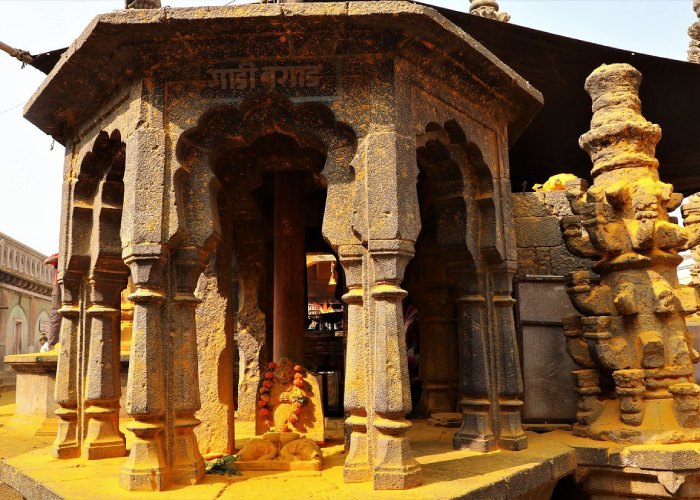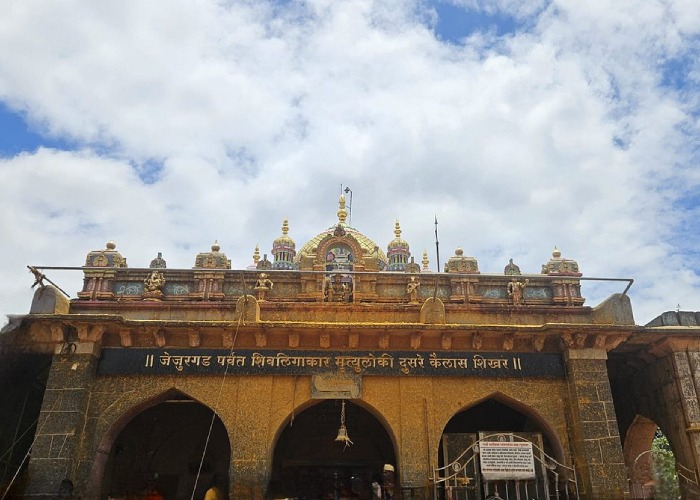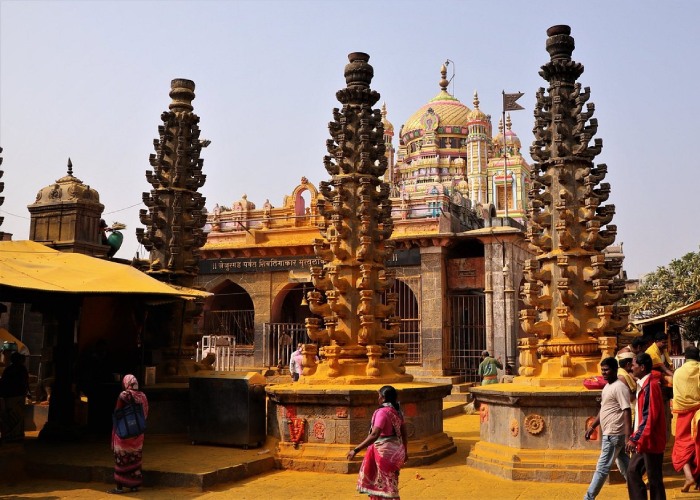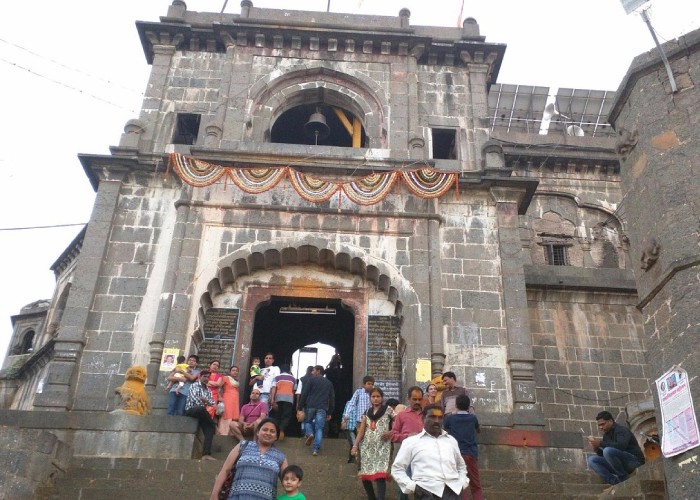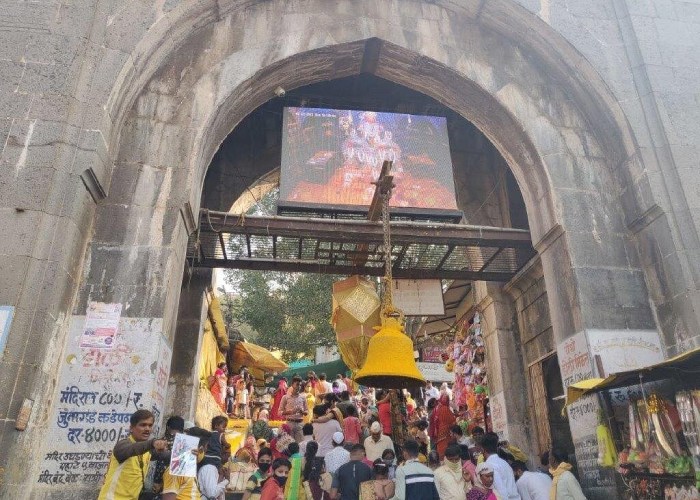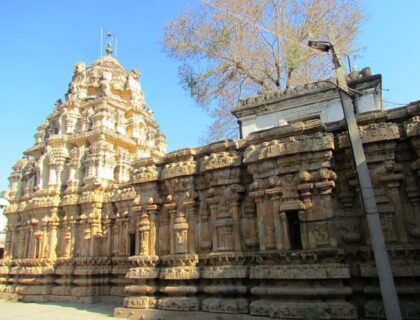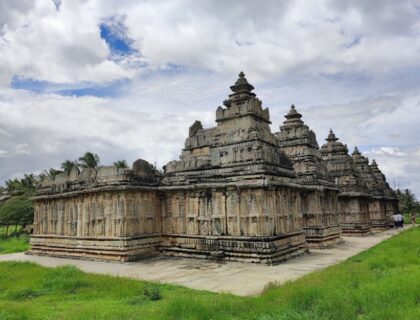Khandoba Temple Jejuri Pune
The Khandoba Temple of Jejuri is a Hindu temple dedicated to the god Khandoba an incarnation of lord Shiva situated on a hill in Jejuri, Maharashtra, India. It is one of the most important Hindu pilgrimage sites in Maharashtra. Jejuri’s Khandoba is a Kuladaivata of many communities with farming families, Brahmins, and nomadic Dhangar tribes from Maharashtra and the Deccan. Khandoba is a tribal deity (a powerful one) who is believed to be an incarnation of Lord Shiva.
The temple is on a hillock called Jayadri, now known as Jejuri. Turmeric is said to have appeared to a group of shepherds as a manifestation of God, so it is considered sacred at the Jejuri temple. Khandoba, also known as Khanderav, Khanderay, Malhari-Martand, and Malhar, is a popular deity in Maharashtra. Khandoba is considered an avatar of the God Shiva. Many people in Maharashtra worship Khandoba as their Kuladevata (ancestral tutelary deity). The Kunbi-Marathas caste, Dhangar tribe, herders, and nomadic people of Maharashtra revere Jejuri’s Khandoba.
Legend/Story Related to Khandoba Temple
According to legend, two demons, Malla and Mani, were upsetting the Earth and causing concern among the sages. When Indra and Vishnu realized they were incompetent, the Sages begged Shiva for help. Shiva took on the identity of Khandoba, rode Nandi (the bull), and led his army into battle against demons. His avatar is described as having a third eye, a semi-circular moon on the forehead, and a torso covered in turmeric. Khandoba eventually defeated the demons after a difficult battle.

Mani begged forgiveness by burning his white horse in front of him. He requested to be present in every temple in Khandoba, and the people served him goat flesh. Shiva granted his wish, transforming him into a demon. What if Khandoba demanded the destruction of the earth and human flesh, Malla wondered? Khandoba became enraged and quickly decapitated Malla, who fell on the shrine’s stairs and was crushed by the devotees’ feet.
History of Khandoba Temple
The worship of Khandoba began in the 12th and 13th centuries. The Yadavas built it in the 12th century. The Khandoba Temple was rebuilt during the reign of the Peshwas.

Chimaji Appa, Peshwa Baji Rao I’s brother, presented the temple with Portuguese church bells from Vasai between 1737 and 1739. After defeating the Portuguese in the Battle of Vasai (1737), he and his Maratha soldiers took the bells from their churches as conquest memorabilia.
The Architecture of Khandoba Temple
The temple sits on a hill at an elevation of 718 metres. The temple can be reached via three flights of stairs from the east, west, and north. The northern steps lead to the temple’s main entrance. The temple is reached by ascending nearly 200 stairs. The steps have approximately 18 arches, 350 deep stambha (lamp pillars), and several shrines surrounding them.

Around one-third of the way up, the steps split and rejoin 50 feet (15 metres) higher. Pilgrims visit the shrine of Khandoba’s minister, Hegadi Pradhan, along one of the uphill paths. The other path used by devotees going down leads to the temple of Banai, Khandoba’s second wife.

This temple, also known as Jejuri gadh, resembles a hill fort. The eight-sided, 320-meter-long fort boundary surrounds a cloistered courtyard, with the main temple shrine in the centre. A brass-coated tortoise with a diameter of 20 feet (6.1 metres) can be found in the courtyard. The temple is built in the Hemadpanthi architectural style, with an outer square hall and an inner sanctum.

The sanctum contains a linga (Shiva’s symbol) and three pairs of images of Khandoba and his first wife, Mhalsa. The temple also houses a Murti of Khandoba riding a horse in warrior form. Khandoba is worshipped using turmeric, belfruit leaves, and naivedhya made from onions and other vegetables. Devotees offer flowers and turmeric to the deity. Devotees throw turmeric into the air as an offering to the god, and as a result, the steps of the hill temple and grounds turn yellow.
Important Facts About Khandoba Temple
- The Khandoba Temple is located in Pune’s Jejuri district. It is the main temple of Khandoba, Maharashtra.
- Jejuri is a town and municipality in the southeast of Pune, located 48 kilometres from Pune Junction.
- The town of Jejuri is famous for one of Maharashtra’s most sacred temples, the Khandoba Temple, and is a popular tourist destination in Pune.
- There are two shrines on a hill in Jejuri Khandoba temple: Kadapathar and Gad-Kot. The Khandoba temple is situated on a hill and provides spectacular views all around.
- To reach the sanctum, one must first climb nearly 200 steps. The temple’s main gateway is flanked by various stone elephant images.
- The entire flat upland above the hill is surrounded by a stone footpath in the centre, which includes the Khandoba shrine.
- The courtyard is surrounded by arched aisles on all sides, from which highly ornate balconies with cypress pillars and cusped arches project.
- This enclosure has three gates, and the temple faces east. The outermost portion is an arched portico with a square mandapa and a garbhagriha.
- The idol of Sri Khandoba housed within the temple is simply stunning. Jejuri Temple houses three weapons: a sword, damaru, and paral. They are exquisite and hold historical significance. Every year during Dussera, the temple hosts a Sword Competition.
- The winner is the person who lifts the temple’s sword the highest for the longest period. It attracts people from all over the state during the Bandara festival.
Best Time to Visit Khandoba Temple
This place is very heavenly and spiritual, and you can visit it all year. However, the best time to visit this temple is during the monsoon and winter seasons. During the monsoon season, this location receives moderate to heavy rainfall, making it appear heavenly with its greenery and bringing freshness elsewhere.
Famous Festivals In Khandoba Temple
- Shravana: For happiness and wealth, many fasts, offerings, and mantras are performed during the fifth month of the Hindu calendar, known as Shravana.
- Mahashivaratri is a fasting ritual in the last week of February – March Begining. It is reminiscent of Lord Shiva bringing Goddess Parvati with him. Priests and the temple committee arrange a Grand Celebration.
- Dussehra – Vijayadashami, more commonly known as Dussehra, and also known as Dasara or Dashain, is a major Hindu festival celebrated every year at the end of Durga Puja and Navaratri. It is observed on the tenth day of the month of Ashvin. The competition of handling the sword on Dussehra Day is very popular, as one has to lift the sword high for a maximum time.
How to Reach Bhuleshwar Temple
By Air: The nearest airport to Khandoba Temple is the Pune International Airport, approximately 49.5 km away.
By Rail: The nearest railway station to Khandoba Temple is Jejuri Railway Junction, which is approximately 3.7 kilometres away. Pune Junction is a major railway station that connects to this place, it is 61 km away from the temple.
By Road: Khandoba Temple Temple is easily accessible by road because it is well connected by a network of roads and highways. If you travel from Pune, the Mandir is about 61 kilometres away and can be reached via the Pune-Pandharpur Road. To get to the temple from Pune, one can take a local bus or hire a taxi.
Also Read – Murudeshwara Temple Gokarna
Support Us
If our content helps you even 1% in gaining information about the temple, please support us by contributing any amount, our UPI ID is - q417999792@ybl Or pay using QR CODE >>> Click Now
Location
Facilities
- Drinking Water
- Pooja Item Shops
- Prasad Shops
- Restaurants Nearby
- Resting Room

